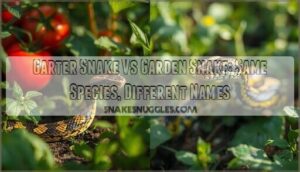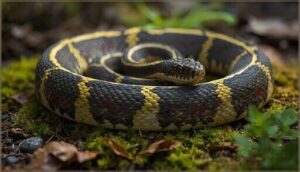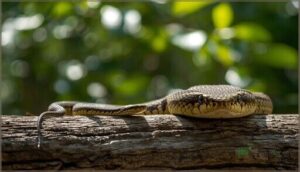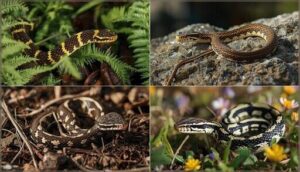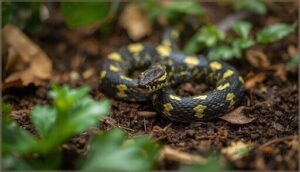This site is supported by our readers. We may earn a commission, at no cost to you, if you purchase through links.
You spot a striped snake gliding through your tomato plants and immediately wonder if you’re dealing with a garter snake or a garden snake. The truth might surprise you: there’s no difference between garter snake and garden snake because they’re the same creature.
This common naming confusion has puzzled homeowners for generations, leading many to believe two separate species share their yards. The term “garden snake” emerged simply because people kept spotting these striped reptiles in their gardens, while “garter snake” refers to their resemblance to old-fashioned striped garters.
Understanding this distinction clears up unnecessary worry and helps you recognize the beneficial pest controller that’s actually living in your landscape.
Table Of Contents
- Key Takeaways
- Garter Snake Vs. Garden Snake: The Real Difference
- Physical Features of Garter Snakes
- Habitat and Behavior in Gardens
- Benefits of Garter Snakes in Yards
- Identifying and Managing Garden Snakes
- Frequently Asked Questions (FAQs)
- Is a garter snake the same as a garden snake?
- How do you tell if a snake is a garden snake?
- What is the difference between a grass snake and a garter snake?
- Are garter snakes good to have in your yard?
- Are garter snakes and gardener snakes the same?
- Do garter snakes pose any danger to pets?
- Can garter snakes climb trees or walls?
- How do I keep garter snakes away from my home?
- At what age do garter snakes become reproductive?
- Do garter snakes bite when handled improperly?
- Conclusion
Key Takeaways
- Garter snakes and garden snakes are identical reptiles—the term “garden snake” emerged as a folk misspelling based on where people commonly spot them, while “garter snake” is the scientifically recognized name for the genus Thamnophis.
- You can identify these snakes by their three distinctive longitudinal stripes (often yellow, white, or greenish) running down a slender body with keeled scales, reaching 18–26 inches in length with females growing noticeably larger than males.
- These nonvenomous snakes provide valuable natural pest control in your yard by consuming slugs, earthworms, insects, and small rodents—reducing your need for chemical pesticides by 20–30% annually without posing significant danger to humans or pets.
- You can safely coexist with garter snakes by maintaining short grass, removing debris piles, sealing foundation gaps, and positioning snake-friendly habitats like rock piles at least 20 feet from high-traffic areas to balance ecological benefits with your comfort.
Garter Snake Vs. Garden Snake: The Real Difference
You’ve probably heard both terms tossed around and wondered if they’re actually different animals. The short answer is no—garter snakes and garden snakes are the same creatures.
Let’s clear up where these names came from and why so many people still mix them up.
Are They Different Species or Names?
You’re probably wondering if “garter snake” and “garden snake” point to different animals. They don’t—both names describe the same snakes in the genus Thamnophis. Scientists use “garter snake,” while “garden snake” reflects common usage based on where people spot them. As a result, snake misidentification is a common issue. This naming confusion trips up snake identification, but the biological status stays clear: you’re looking at one group of species, not two.
| Aspect | Garter Snake | Garden Snake |
|---|---|---|
| Scientific Classification | Genus Thamnophis, family Colubridae | Not a valid taxonomic category |
| Common Usage | Formal herpetology and wildlife guides | Informal backyard observations |
| Species Identity | 35+ recognized species | Same animals, different nickname |
Origins of The “Garden Snake” Term
The name “garden snake” originated when homeowners observed garter snakes resting in vegetable beds and flower borders. Since “garter”—a clothing fastener—was unfamiliar to many, people misheard it as “garden.” This folk etymology spread through word-of-mouth, further reinforced by the snakes’ habit of hunting slugs in moist soil. Today, “garden snake” remains a common misspelling and misinterpretation, despite scientists never adopting the term. They thrive in various habitats, ranging from grasslands to urban areas.
| Term Evolution | Detail |
|---|---|
| First Record | “Garter snake” appears in English by 1773 |
| Garden Link | Snakes frequent residential yards and compost areas |
| Phonetic Shift | “Garter” misheard as “garden,” “gardener,” or “garten” |
| Modern Use | Wildlife agencies correct “garden snake” in outreach |
Common Naming Confusion Explained
You’ve probably called them “garden snakes” your whole life—don’t worry, you’re not alone. People swap “garter” and “garden” so often that wildlife agencies routinely correct the mix-up. Regional vernacular variations like “gardener snake” or “gartner snake” stem from phonetic similarity rather than scientific nomenclature. Below, you’ll see how interchangeability persists despite formal naming.
| Common Misspelling | Why It Happens |
|---|---|
| “Garden snake” | Snakes live in yards and gardens |
| “Gardener snake” | Folk association with gardening |
| “Gartner snake” | Phonetic confusion with “garter” |
| “Grass snake” | Faint stripes blend into lawns |
Physical Features of Garter Snakes
Once you know garter snakes and garden snakes are the same animal, it helps to recognize what they actually look like.
These snakes have distinctive features that make them easy to spot in your yard or garden. Let’s look at their markings, body size, and the most common species you might encounter.
Body Markings and Color Patterns
You’ll recognize garter snakes by their bold longitudinal stripes—one down the back and two along the sides. Background color varies from black to dark olive or brown, often with checkered patterns or red spots between the stripes.
Their belly patterns are usually pale yellow or white, and the keeled scales give them a slightly rough texture compared to smooth-scaled garden snakes.
Size, Shape, and Sexual Dimorphism
Most garter snakes reach 18–26 inches as adults, though some top 4 feet. Females grow noticeably larger than males, a trait called Female Dimorphism. Body Proportions remain slender—usually 40 times longer than wide.
Growth Differences emerge early: females mature at 24 inches, males around 18. Tail Morphology also varies by sex: males carry longer tails relative to body length, while females develop broader heads for their Adult Size Range.
Notable Garter Snake Species
You’ll find over 35 garter snakes across North America, each adapted to unique habitats. The eastern garter snake thrives from Canada to Florida in moist woodlands, while western terrestrial snakes climb to nearly 13,000 feet in mountains. Butler’s garter snake faces conservation threats in the Great Lakes, and plains species prefer drier grasslands.
These species distribution patterns reflect dietary preferences and morphological traits shaped by local environments.
Habitat and Behavior in Gardens
Garter snakes thrive in a surprising range of habitats, from wetlands and meadows to the edges of your backyard. Their ability to adapt to different environments explains why you’ll spot them near gardens, ditches, and even suburban sidewalks.
Let’s look at where these snakes prefer to live, what they hunt, and how their behavior shifts with the seasons.
Preferred Environments and Geographic Range
You’ll encounter garter snakes across nearly every corner of North America, from Canada’s subarctic plains to Costa Rica. These adaptable reptiles thrive in habitat diversity—from wetland marshes to suburban yards—thanks to impressive climate adaptation.
Regional variations show eastern populations favoring moist meadows, while western snakes stay closer to water proximity. Urban habitats work fine if you’ve got cover and moisture nearby.
Typical Diet and Hunting Habits
You might be surprised to learn that amphibians and earthworms make up about 80% of a garter snake’s diet. Prey composition shifts as these reptiles grow—juveniles favor earthworms and leeches, while adults over 60 cm prefer frogs and salamanders.
Hunting techniques include ambush strikes and mildly toxic saliva to immobilize insects and invertebrates. Feeding frequency peaks at 40% during spring, with species variations influencing food preferences.
Seasonal Activity and Breeding
When do you see these reptiles most often in your yard? Seasonal behavior follows a predictable pattern: garter snakes emerge from brumation in March or April, with males appearing first. Mating timing peaks immediately after emergence, often forming dramatic breeding aggregations.
Reproductive biology involves live birth in late summer. Garden activity remains high through fall before snakes retreat underground for winter.
Benefits of Garter Snakes in Yards
If you’ve spotted a garter snake in your yard, you might wonder whether it’s a friend or a nuisance. The truth is, these snakes offer real benefits that can make your outdoor space healthier and easier to manage.
Let’s look at the key ways garter snakes help your garden thrive.
Natural Pest Control Roles
Think of garter snakes as your garden’s unpaid pest control crew. They tackle problems you’d otherwise fight with chemicals or traps, keeping your plants healthier while you save money and effort.
Garter snakes are your garden’s free pest control crew, protecting plants and reducing your need for chemicals or traps
- Slug consumption: Northwestern garter snakes can eat over 50% slugs in their diet, protecting vulnerable seedlings
- Rodent control: Larger snakes hunt mice and voles that damage roots
- Insect regulation: Grasshoppers, beetles, and crickets all fall prey
- Pesticide reduction: Gardens with snakes need 20–30% fewer chemicals annually
Ecological Importance in Gardens
Beyond pest control, garter snakes boost your garden’s overall health in surprising ways. Their hunting reduces soil-dwelling pests that damage roots, supporting soil health and plant vitality.
Some species even aid seed dispersal by carrying fruits, helping garden plants spread naturally.
Gardens with healthy snake populations often show better water quality through reduced erosion and stronger vegetation cover, creating resilient ecosystems that handle stress response like drought more effectively.
Safety and Interactions With Humans
Having garter snakes in your garden or backyard actually poses minimal risk to you and your family. These snakes flee in over 90% of encounters, and bite risk stays under 5% during typical snake encounters.
Their mild venom isn’t medically significant for humans, with less than 0.1% experiencing allergic reactions. Public health agencies classify them as low-risk, making snake safety straightforward with basic precautions during safe handling.
Identifying and Managing Garden Snakes
Knowing whether you’ve actually spotted a garter snake helps you feel more confident about what’s slithering through your garden. Once you’ve made a positive ID, you can decide whether to simply leave the snake alone or take steps to make your yard less inviting.
The following points cover how to recognize garter snakes, keep yourself safe, and manage their presence responsibly.
Telling Garter Snakes From Other Species
When you spot a snake in your yard, a few quick checks can confirm whether it’s a garter snake. Look for three bright longitudinal stripes running down the body—often yellow, white, or greenish—paired with keeled scales that give a matte texture.
Check these features:
- Head shape: Garter snakes have wider heads than necks with round pupils, unlike triangular-headed pit vipers.
- Body proportions: They’re slender, usually 18–51 inches long, with females larger than males.
- Color variations: Watch for checkered side patterns or red spots between stripes—ribbon snakes lack these markings.
Behavioral cues help too. Garter snakes often release a strong musk when disturbed and prefer moist garden beds where they hunt earthworms and amphibians.
Snake Safety and Prevention Tips
While garter snakes don’t pose serious bite risk factors, your garden habits matter. Keep grass trimmed to 2–4 inches around your home and remove debris piles—simple habitat modification that cuts snake encounters by 50–75%.
Use exclusion techniques like sealing gaps wider than a quarter-inch, wear boots in dense vegetation, and manage rodents by securing pet food. These protective measures reduce unexpected meetings in backyards while maintaining natural pest control.
Responsible Snake Management in Gardens
Instead of killing or removing every snake you find, use coexistence strategies that balance your comfort with ecological benefits. Garden habitat modification works—placing rock piles 20 feet from patios keeps garter snakes nearby for garden pest control without close encounters. For targeted protection:
- Install snake proof fencing around play areas (36 inches high, 0.25-inch mesh)
- Seal structural gaps larger than a quarter-inch
- Position compost piles at property edges
- Choose non lethal removal through live trapping when necessary
- Design snake friendly habitats in low-traffic zones
These practical snake prevention approaches support natural predators while managing snake habitats around homes, letting beneficial species handle slugs without conflict.
Frequently Asked Questions (FAQs)
Is a garter snake the same as a garden snake?
You’ve likely heard both names tossed around when spotting a striped snake near your tomatoes. Garter snakes and garden snakes are the same nonvenomous snakes—just different nicknames for identical snake species.
How do you tell if a snake is a garden snake?
You can identify a garden snake by looking for three light stripes running lengthwise over a darker body. Most display slender builds and round pupils, and prefer moist areas near your home.
What is the difference between a grass snake and a garter snake?
A child spots a striped snake in Pennsylvania and calls it a “grass snake”—but it’s actually a garter snake.
True grass snakes (Natrix) live in Europe, while garter snakes (Thamnophis) inhabit North America as distinct evolutionary groups.
Are garter snakes good to have in your yard?
You’ll benefit from having garter snakes in your yard. They provide excellent pest control by eating slugs, insects, and small rodents while supporting backyard biodiversity and a healthy yard ecosystem without posing danger to people or pets.
Are garter snakes and gardener snakes the same?
Yes, garter snakes and “gardener snakes” are the same species. “Gardener” is simply a common naming error for garter snakes—those striped, harmless Thamnophis species found throughout North American yards and gardens.
Do garter snakes pose any danger to pets?
Garter snakes are nonvenomous and rarely pose serious danger to pets. Snake bite symptoms include mild swelling or irritation, while wildlife ingestion risks mainly involve gastrointestinal upset rather than venom effects requiring emergency care.
Can garter snakes climb trees or walls?
Though mostly ground-dwellers, you’ll sometimes spot these snakes inching up rough bark or textured walls.
Their slender bodies let them climb low branches and shrubs when hunting prey or seeking warmth.
How do I keep garter snakes away from my home?
To prevent snake entry, seal foundation cracks and gaps, and remove debris piles and firewood stacks.
Mow lawns short and drain standing water to reduce food sources.
Install fine-mesh barriers where needed.
At what age do garter snakes become reproductive?
Most garter snakes reach sexual maturity between one and two years old. Males usually mature faster—around 5 years—while females need closer to two years before they’re ready to reproduce and start breeding cycles.
Do garter snakes bite when handled improperly?
Yes, improper handling increases bite risk factors through defensive mechanisms. When you grab or restrain them suddenly, especially when warm, they may strike.
Proper snake handling—gentle support, calm movements—greatly reduces bites.
Conclusion
The next time you spot those telltale stripes weaving through your flower beds, you’ll know the secret: there’s no difference between garter snake and garden snake. They’re one and the same—nature’s pest patrol working quietly beneath your vegetables.
These misunderstood reptiles deserve recognition, not fear. By welcoming them into your landscape, you’re inviting a natural balance that keeps slugs, insects, and rodents in check while your garden thrives.

